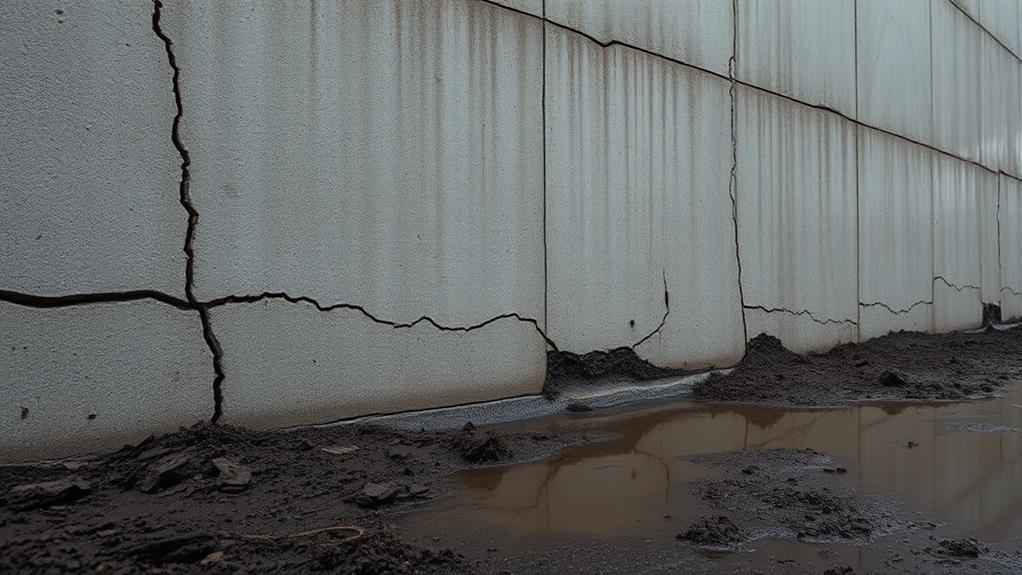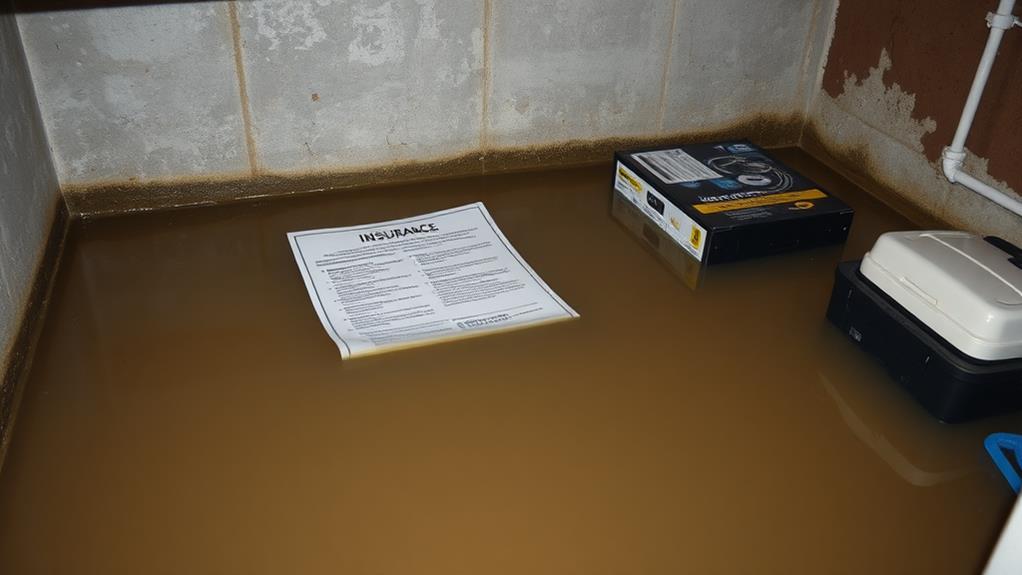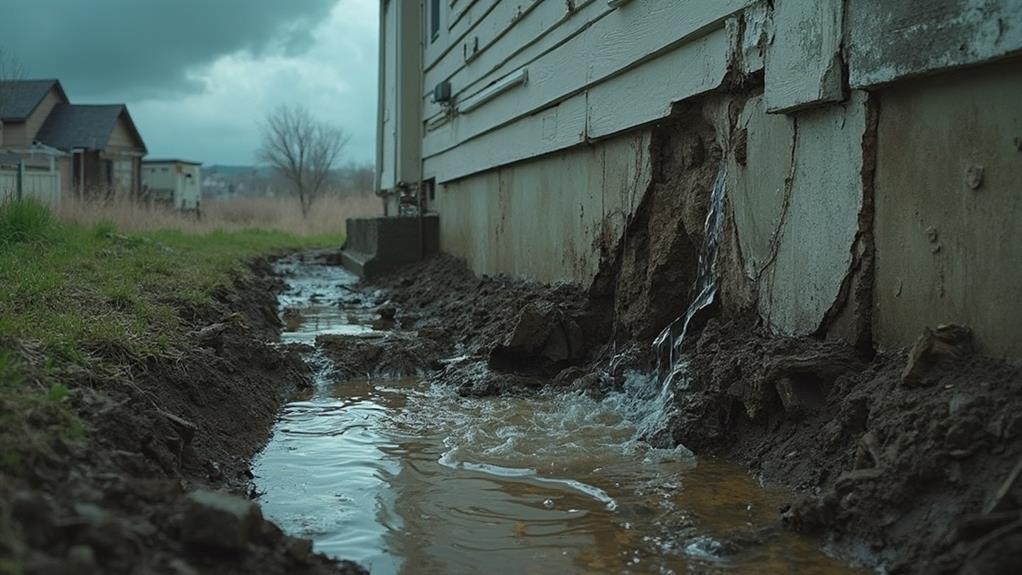Water damage to your home's foundation after a storm is a silent but serious threat. Heavy rainfall can saturate the soil around your house, creating hydrostatic pressure that forces water through cracks and pores in the foundation. This infiltration can lead to structural issues, mold growth, and soil erosion. Signs of damage include visible cracks, moisture stains, and uneven floors. Immediate action is crucial: inspect thoroughly, remove standing water, and improve drainage. Long-term prevention involves regular maintenance, waterproofing, and professional assessments. Understanding the mechanisms of water damage and implementing protective measures can safeguard your home's structural integrity for years to come.
Understanding Foundation Water Damage

Many homeowners underestimate the potential for water damage to their home's foundation following severe storms. Foundation water damage occurs when excessive moisture penetrates the concrete or masonry structure, leading to various issues that can compromise the integrity of the entire building.
Water can infiltrate foundations through cracks, gaps, or porous materials, especially during heavy rainfall or flooding. As water accumulates around the foundation, hydrostatic pressure builds up, forcing moisture into the structure. This intrusion can cause concrete to deteriorate, steel reinforcements to corrode, and soil beneath the foundation to erode or shift.
The damage may not be immediately apparent, often manifesting over time as cracks, settling, or bowing walls. Prolonged exposure to moisture can also foster mold growth, further jeopardizing the structure and potentially causing health issues for occupants.
Understanding the mechanisms of foundation water damage is crucial for homeowners to take preventive measures. Proper drainage systems, regular inspections, and timely repairs are essential to mitigate the risk of severe foundation damage. By addressing potential vulnerabilities early, homeowners can protect their property's structural integrity and avoid costly repairs in the future.
Storm's Impact on Home Foundations
While storms can wreak havoc on various parts of a home, their impact on foundations is particularly concerning. Heavy rainfall and flooding can saturate the soil surrounding a foundation, leading to hydrostatic pressure buildup. This pressure can cause cracks, shifts, or even significant structural damage to the foundation.
High winds during storms can also contribute to foundation issues. As trees sway and potentially fall, their root systems can disturb the soil around the foundation, causing movement and instability. Additionally, wind-driven rain can penetrate small cracks or gaps in the foundation, exacerbating existing problems.
Storm surges in coastal areas pose a severe threat to foundations. The forceful water can erode soil beneath the structure, potentially leading to settlement or complete failure. In extreme cases, floodwaters may even lift a home off its foundation.
Post-storm, the rapid drying of saturated soil can cause further complications. As the ground contracts, it may create voids beneath the foundation, resulting in uneven settling. This can manifest as cracks in walls, stuck doors, or sloping floors. Regular inspections and prompt repairs are crucial to mitigate storm-related foundation damage.
Signs of Foundation Water Damage

Although foundation water damage can be insidious, several telltale signs indicate potential issues. Visible cracks in the foundation walls or floor are primary indicators, especially if they widen over time. Moisture stains or dampness on walls, floors, or ceilings in the basement or crawl space suggest water infiltration. Mold growth, musty odors, or increased humidity levels are also red flags.
Exterior signs include soil erosion around the foundation, standing water near the house after rain, or water stains on exterior walls. Inside, look for doors or windows that stick or don't close properly, as this may indicate foundation shifting.
Uneven or sloping floors, gaps between walls and floors or ceilings, and bowed or bulging walls are serious symptoms of foundation damage. Peeling paint or wallpaper, particularly in ground-level rooms, can signify moisture issues. In extreme cases, you may notice pooling water in the basement or crawl space.
It's crucial to address these signs promptly, as untreated water damage can lead to severe structural problems and costly repairs.
Common Causes of Infiltration
Understanding the root causes of water infiltration is key to preventing foundation damage. Several factors contribute to water seepage into foundations during and after storms.
Poor drainage is a primary culprit, often resulting from improperly graded landscapes that direct water towards the house instead of away from it. Clogged or inadequate gutters and downspouts can also lead to water accumulation near the foundation.
Cracks in the foundation walls or floor provide direct entry points for water. These may develop due to settling, hydrostatic pressure, or freeze-thaw cycles. Poorly sealed windows and doors in basement areas can allow water ingress during heavy rains or flooding. Additionally, porous building materials like concrete can absorb moisture over time, leading to gradual deterioration.
Improperly installed or damaged waterproofing membranes around the foundation can fail to repel water effectively. In some cases, a high water table or underground springs may cause constant moisture pressure against the foundation. Lastly, plumbing leaks, both internal and external, can contribute to foundation water damage if left unaddressed. Identifying and addressing these common infiltration causes is crucial for maintaining the integrity of your home's foundation.
Immediate Actions After a Storm

Assessing your home's foundation immediately after a storm is crucial for preventing further damage. Begin by conducting a thorough visual inspection of your property, paying close attention to the foundation walls, basement, and crawl spaces. Look for signs of water intrusion, cracks, or shifting.
Remove standing water promptly using pumps or wet vacuums to minimize moisture absorption into the foundation. Ensure proper drainage by clearing gutters, downspouts, and surrounding landscaping of debris.
If you notice any foundation cracks, even small ones, document them with photos and measurements for insurance purposes and future monitoring.
Ventilate affected areas to promote drying and prevent mold growth. Use dehumidifiers and fans to accelerate the process. If you suspect significant damage, contact a professional structural engineer or foundation specialist for a thorough assessment. They can identify hidden issues and recommend appropriate repairs.
Take immediate action to address any obvious structural concerns, such as shoring up sagging floors or walls. Finally, review your insurance policy and contact your provider if necessary to initiate the claims process for covered storm-related foundation damage.
Long-Term Prevention Strategies
Implementing long-term prevention strategies is essential for safeguarding your home's foundation against future storm damage. Begin by improving drainage around your property. Install a robust gutter system with downspouts that direct water at least 10 feet away from the foundation. Consider adding French drains or a swale to further divert water from the house.
Maintain proper grading around your home, ensuring the soil slopes away from the foundation at a rate of 6 inches over 10 feet. Regularly inspect and seal any cracks in the foundation walls or floor to prevent water infiltration. Install a sump pump in the basement or crawl space to remove excess water during heavy rainfall.
Consider waterproofing your foundation walls, both inside and outside, using high-quality sealants or membranes. Plant trees and shrubs at a safe distance from your home to prevent root systems from compromising the foundation. Regularly trim vegetation near the house to reduce moisture retention. Install window wells with proper drainage for below-grade windows. Finally, schedule annual professional inspections to catch and address potential issues before they escalate into major problems.
Professional Assessment and Repairs

When storm damage occurs, it's crucial to seek professional assessment and repair services to ensure the long-term stability of your home's foundation. Certified structural engineers and foundation specialists can accurately evaluate the extent of damage and recommend appropriate remediation measures. These experts utilize advanced tools like moisture meters, thermal imaging cameras, and ground-penetrating radar to detect hidden issues that may not be visible to the untrained eye.
Professional assessment typically involves a thorough inspection of the foundation, including examination of cracks, shifts, and signs of water intrusion. Experts will also assess the surrounding soil conditions and drainage systems to identify potential contributing factors. Based on their findings, they'll provide a detailed report outlining the necessary repairs and their urgency.
Repairs may range from simple crack injections and waterproofing to more extensive measures like underpinning or installing drainage systems. It's essential to hire licensed contractors experienced in foundation repair to ensure quality workmanship. They should use industry-approved techniques and materials, providing warranties for their work. Regular follow-up inspections are often recommended to monitor the effectiveness of repairs and detect any new issues early on.
Cost Implications of Foundation Damage
The financial impact of foundation damage can be substantial for homeowners. Repair costs vary significantly depending on the extent of the damage and the required remediation methods. Minor repairs, such as filling small cracks or applying waterproofing sealants, may range from $500 to $3,000.
However, more severe issues like structural shifting or extensive water damage can escalate costs to $10,000 or more. Foundation repairs often involve specialized equipment and expertise, contributing to higher expenses. Hydraulic piers for stabilization, basement waterproofing systems, or complete foundation replacement are among the costlier interventions, potentially reaching $20,000 to $100,000 in extreme cases.
Additional expenses may include landscaping restoration, interior repairs, and temporary relocation during extensive work. Insurance coverage for foundation damage varies, with many policies excluding issues caused by poor maintenance or gradual deterioration. Homeowners should review their policies carefully and consider additional coverage options.
Proactive measures, such as regular inspections and prompt attention to minor issues, can help mitigate long-term costs. Ultimately, investing in timely repairs and preventive measures can save significant money compared to addressing extensive foundation damage later.
Insurance Coverage for Water Damage

Homeowners often face uncertainty when it comes to insurance coverage for water damage resulting from storms. Standard homeowners insurance policies typically cover sudden and accidental water damage, such as burst pipes or roof leaks.
However, coverage for foundation damage caused by flooding or groundwater seepage is more complex. Most policies exclude damage from floods, requiring separate flood insurance through the National Flood Insurance Program (NFIP) or private insurers. Even with flood insurance, coverage for foundation issues may be limited.
Gradual water damage, such as long-term seepage or poor drainage, is generally not covered by standard policies. To ensure adequate protection, homeowners should carefully review their policies and consider additional coverage options.
Some insurers offer endorsements for water backup or sump pump failure, which can help mitigate foundation-related water damage. It's crucial to document all damage thoroughly and contact the insurance provider promptly after a storm.
Homeowners in high-risk areas may need to invest in preventive measures, such as French drains or waterproofing, to maintain insurability and minimize potential losses. Regular foundation inspections and maintenance can also help prevent costly damage and insurance claim denials.
Frequently Asked Questions
Can Foundation Water Damage Affect My Home's Resale Value?
Foundation water damage can significantly impact your home's resale value. It indicates potential structural issues, which can deter buyers and lead to lower offers. Addressing and disclosing such damage is crucial when selling a property.
How Long Does It Typically Take for Water Damage to Become Visible?
Like a hidden time bomb, water damage often lurks unseen. Visible signs may appear within hours or take weeks to manifest, depending on factors such as water volume, materials affected, and environmental conditions. Swift action is crucial.
Are There Specific Building Materials More Resistant to Water-Induced Foundation Damage?
Certain building materials offer superior resistance to water-induced foundation damage. Concrete with waterproofing admixtures, fiber-reinforced polymers, and engineered wood products are more resilient options. Additionally, proper drainage systems and waterproof membranes enhance overall foundation protection against moisture damage.
Can Landscaping Choices Impact the Likelihood of Foundation Water Damage?
Ah, yes, because nothing says "curb appeal" like a moat around your castle! In reality, smart landscaping choices can significantly reduce foundation water damage. Proper grading, strategic plant placement, and efficient drainage systems are key to protecting your home's foundation.
Are There DIY Methods to Test for Hidden Moisture in Foundation Walls?
Several DIY methods can detect hidden moisture in foundation walls, including:
- Moisture meters
- Infrared cameras
- Visual inspection for discoloration
- Tape-sealed plastic sheets to test for condensation
- Calcium chloride moisture test kits
These tools help homeowners identify potential issues early.
Conclusion
Foundation water damage presents a formidable challenge to homeowners in the aftermath of storms. Vigilance in identifying early signs, coupled with proactive prevention measures, is crucial for maintaining structural integrity. Professional assessment and timely repairs can mitigate extensive damage and associated costs. While insurance coverage varies, understanding policy details is essential. Ultimately, safeguarding a home's foundation against water infiltration is not just a wise investment, but a critical step in keeping the wolf from the door.

